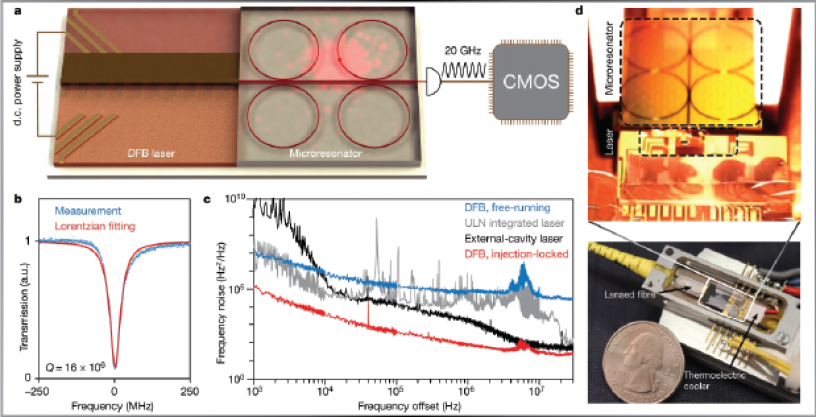
Research team demonstrates stable, turnkey operation of chip-scale optical frequency combs, taking a critical step towards enabling broader manufacture and use of high-performance photonics
Jun 18, 2020
Optical frequency synthesizers – systems that output laser beams at precise and stable frequencies – have proven extremely valuable in a variety of scientific endeavors, including space exploration, gas sensing, control of quantum systems, and high-precision light detection and ranging (LIDAR). While they provide unprecedented performance, the use of optical frequency synthesizers has largely been limited to laboratory settings due to the cost, size, and power requirements of their components. To reduce these obstacles to widespread use, DARPA launched the Direct On-Chip Digital Optical Synthesizer (DODOS) program in 2014. Key to the program is the miniaturization of necessary components and their integration into a compact module, enabling broader deployment of the technology while unlocking new applications.
To accomplish its goals, DODOS is leveraging advances in microresonators – tiny structures that store light in microchips – to produce optical frequency combs in compact integrated packages. Frequency combs earn their name by converting a single-color input laser beam into a sequence of many additional colors that are evenly spaced and resemble a hair comb. With a sufficiently wide array of comb “teeth,” innovative techniques to eliminate noise become possible that make combs an attractive option for systems needing precise frequency references.
Until recently, creating frequency combs from microresonators was a complex affair that required sophisticated control schemes, dedicated circuitry, and oftentimes, an expert scientist to carefully observe and fine-tune the operation. This is primarily due to the sensitive properties of the microresonator, which needs the perfect amount of light at a special operating frequency – or color – to be provided by an input laser in order for the comb to turn on and even then, producing a coherent or stable comb state could not be guaranteed every time.
A new result published in Nature by a team of academic researchers led by University of California at Santa Barbara (UCSB) entirely changes this condition. By closely linking two microchips holding a laser and microresonator, the team was able to cause the two devices to strongly affect each other's operation. In this simplified structure, the microresonator provides feedback that tunes the laser to the correct conditions needed to generate the comb, and to operate in the special “soliton” mode that features the broad array of comb “teeth” necessary for optical frequency synthesizers.
Critically important to future deployment, the research team’s demonstration is also much more convenient to operate. Because of careful choices in the design of the system, simply turning on the laser automatically starts the comb. The "turnkey" operation devised by the researchers dramatically simplifies the implementation of systems that need combs in order to perform special functions. By eliminating the specialized electronics and optics that are usually needed in between the devices, the simplified structure reduces scale, power, and cost requirements while making the combs robust to environmental and temperature disturbances.
“The UCSB team’s accomplishment could have broad reaching implications for a number of commercial and defense photonics applications – from navigation systems to optical clocks to coherent communications,” said Dr. Gordon Keeler, the DARPA program manager leading DODOS. “This work brings us one step closer to the creation of the next-generation of optical frequency control technology that isn’t restricted to a lab, but rather available for real-world use.”
This work builds on previous accomplishments the UCSB-led team made in collaboration with the National Institute of Standards and Technology (NIST) on the DODOS program in 2018 around the successful miniaturization of optical frequency synthesizer components. More information on this accomplishment is available here, https://www.darpa.mil/news-events/2018-04-25.
Image Caption: This image depicts the integrated soliton microcomb chip developed by the DODOS research team from University of California Santa Barbara, California Institute of Technology, and Institute of Physics, Swiss Federal Institute of Technology Lausanne (EPFL). Image Source: Nature
# # #
Media with inquiries should contact DARPA Public Affairs at outreach@darpa.mil
Associated images posted on www.darpa.mil and video posted at www.youtube.com/darpatv may be reused according to the terms of the DARPA User Agreement, available here: http://go.usa.gov/cuTXR.
Tweet @darpa
